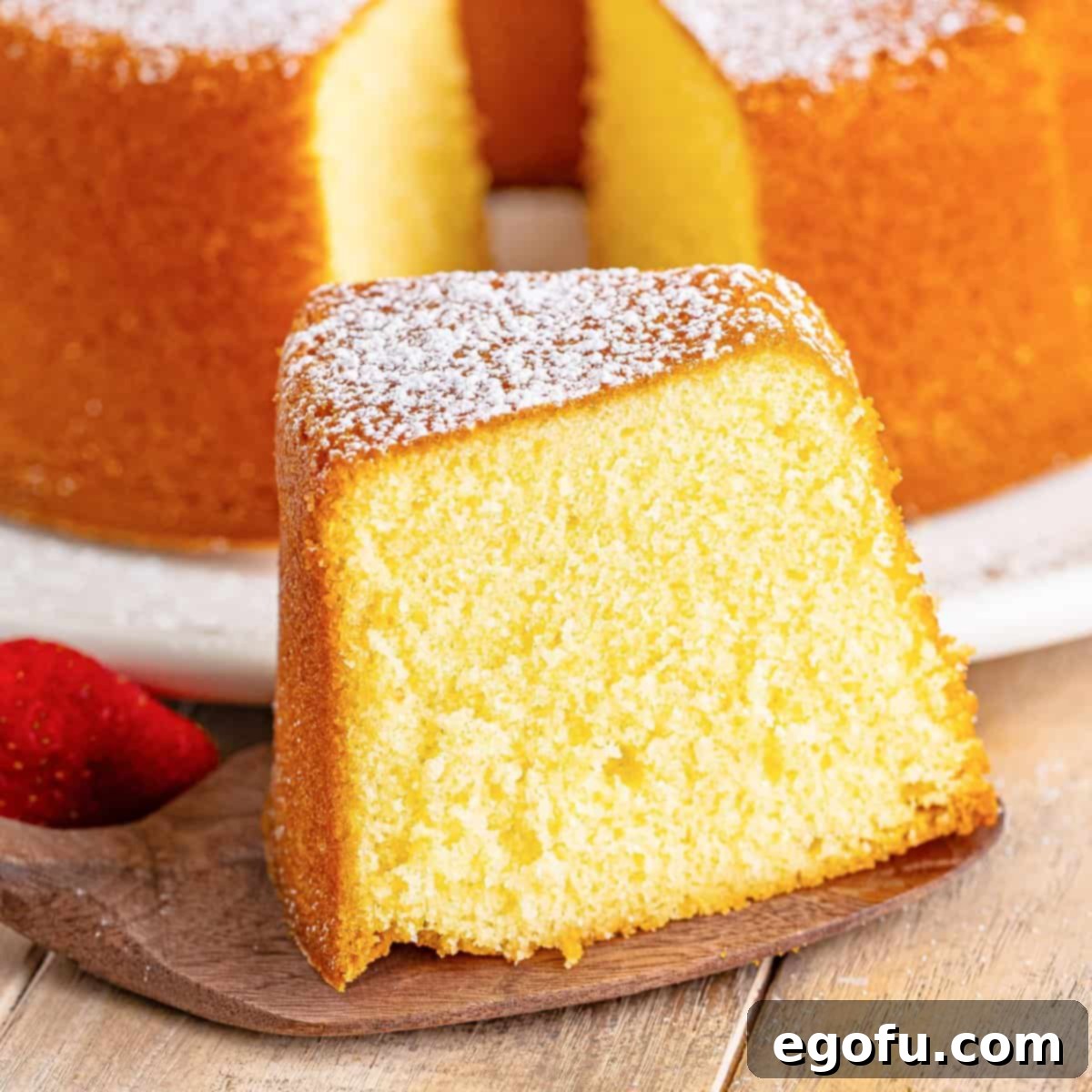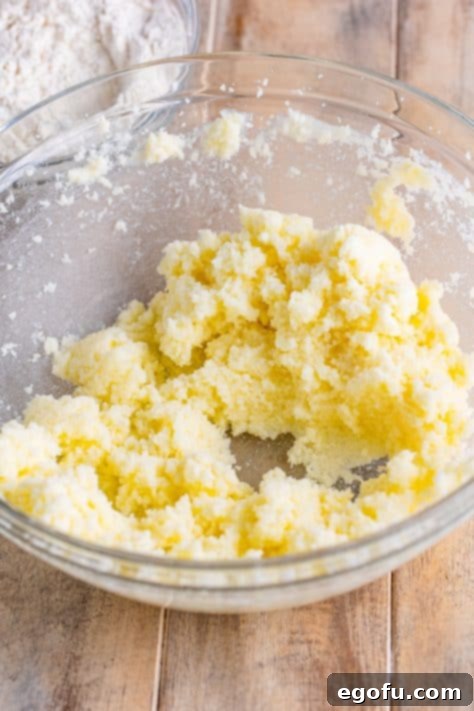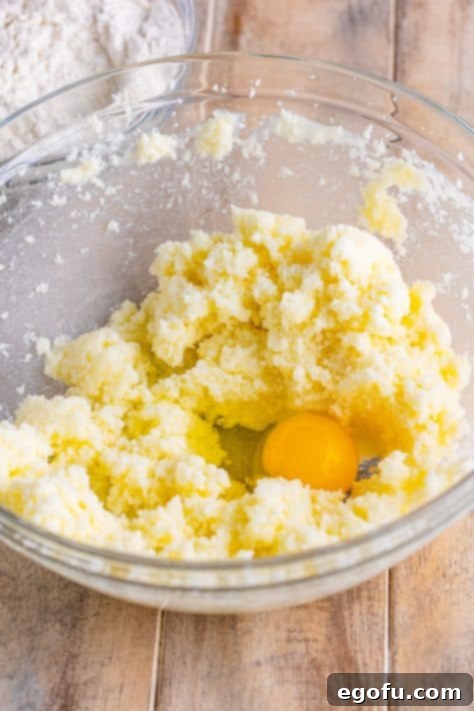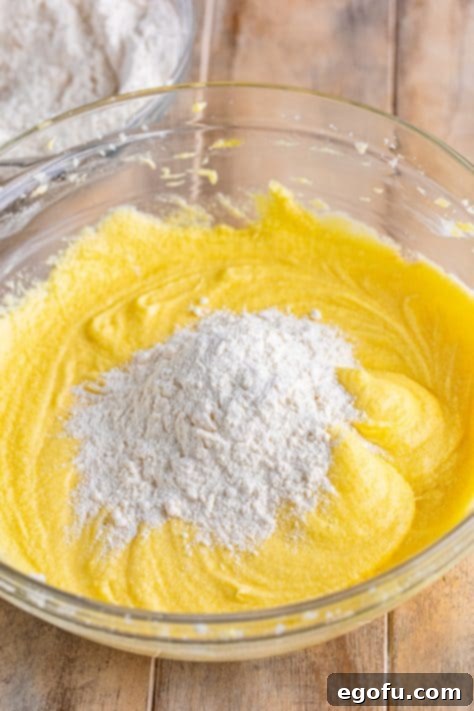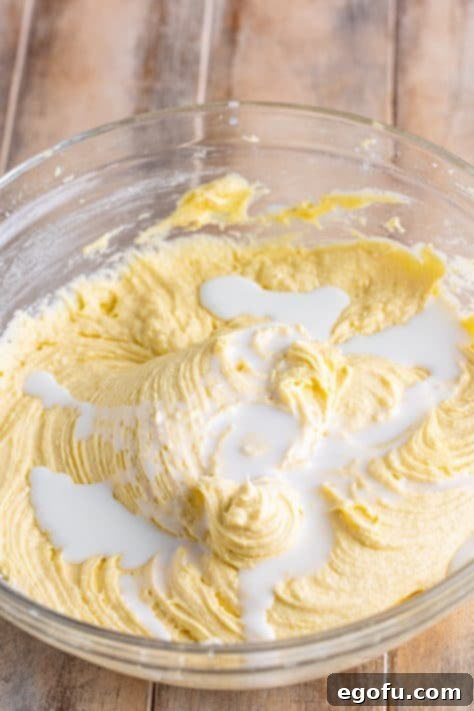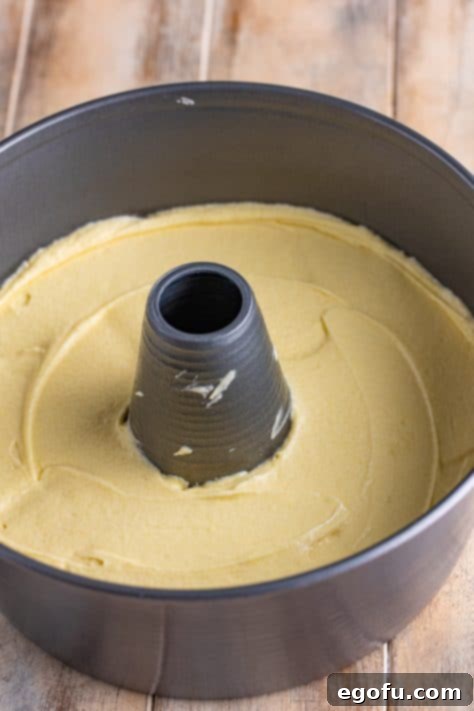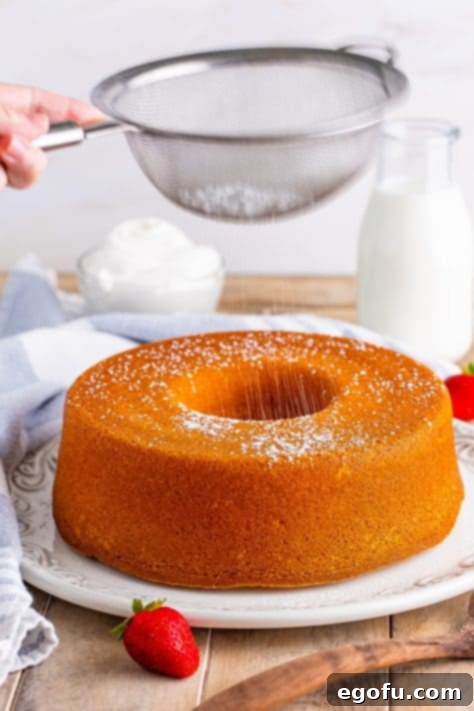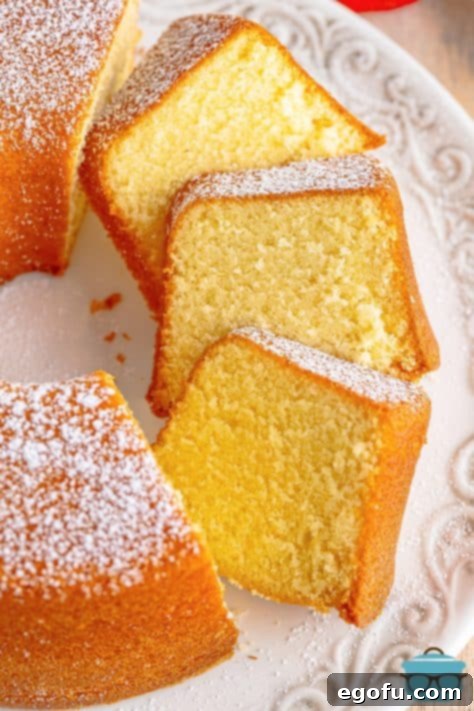Welcome to the world of classic Southern baking, where tradition meets irresistible flavor in every golden, buttery bite. Today, we’re celebrating the iconic Southern Pound Cake – a timeless dessert that has graced tables and delighted palates for generations. Far from being just any cake, this is a masterpiece of simplicity and rich taste, a testament to the idea that some of the best things in life are crafted with the fewest, finest ingredients. If you’re searching for a reliable, easy-to-make dessert that promises to impress, whether for a special holiday gathering, a casual family meal, or simply a comforting treat, this homemade vanilla butter cake is your answer. Its dense, moist crumb and delicate vanilla aroma make it an enduring favorite, perfect for any occasion.
The Enduring Appeal of Southern Pound Cake: A Timeless Classic
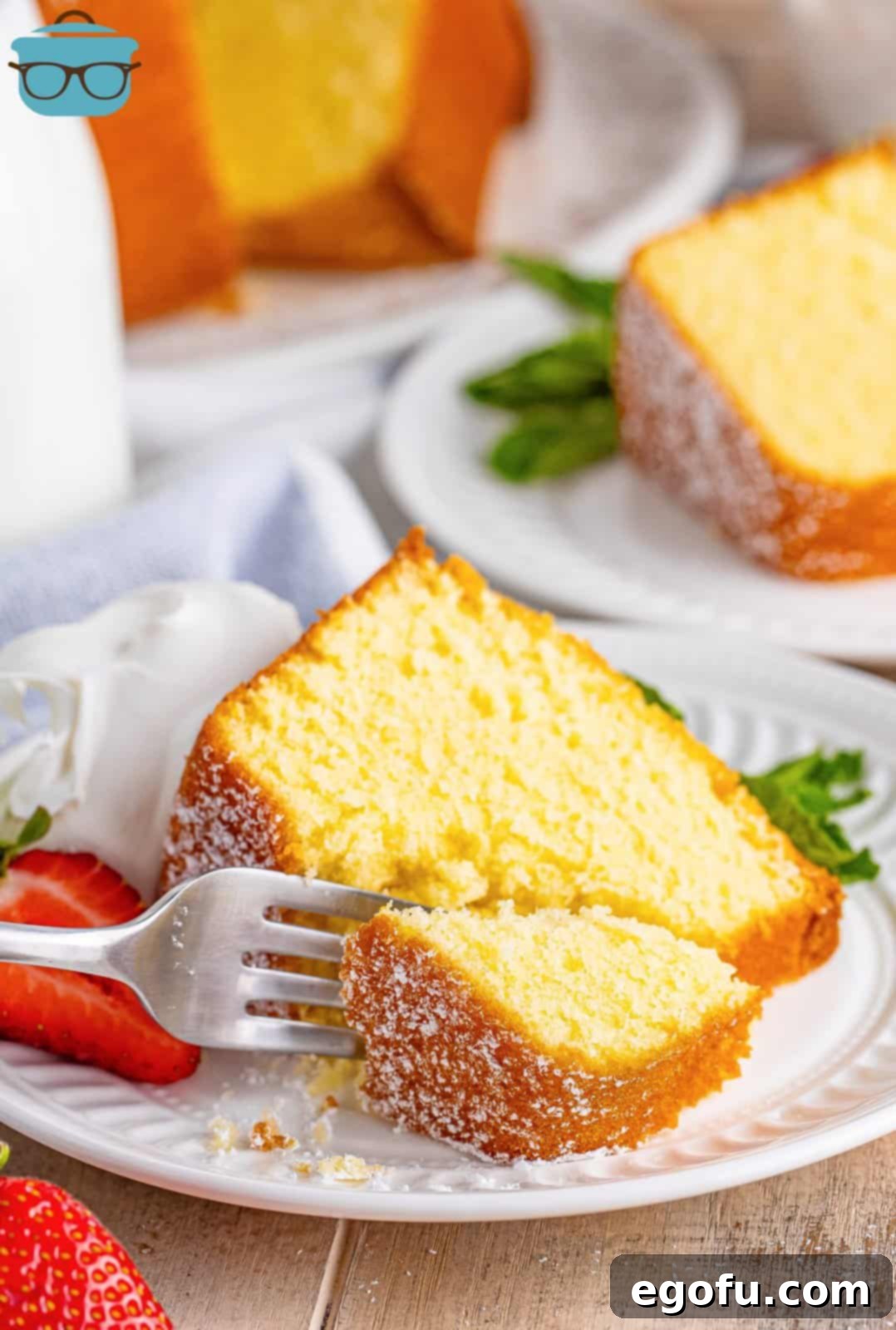
There’s a reason the Southern Pound Cake remains a cherished dessert in homes across the South and beyond: its unparalleled simplicity, combined with a depth of flavor that speaks of home and comfort. This isn’t a cake laden with complex fillings or elaborate frostings; its beauty lies in its pure, unadulterated taste of vanilla and butter. Made from just a handful of staple ingredients – butter, sugar, eggs, and flour – it comes together with surprising ease, proving that you don’t need a gourmet pantry to create something extraordinary. The result is a cake that is dense yet tender, wonderfully moist, and possesses a slightly crisp, golden exterior that yields to a luscious interior. It’s the kind of dessert that evokes nostalgia, tastes like childhood, and is versatile enough to be served plain, with a dusting of powdered sugar, or adorned with fresh fruit and cream. Whether you’re a seasoned baker or just starting your culinary journey, this recipe offers a foolproof path to a truly satisfying dessert experience.
Frequently Asked Questions About Pound Cake
The name “pound cake” is a direct nod to its traditional origins. The original recipe, which dates back to the 18th century, famously called for one pound each of the core ingredients: butter, sugar, eggs, and flour. This simple, balanced ratio was revolutionary in its time, creating a rich, dense, and wonderfully sweet butter cake. While modern recipes often adjust these proportions for lighter textures or to fit specific pan sizes, the essence of that foundational 1:1:1:1 ratio—and the iconic name—has remained. This traditional approach to baking yielded a cake with a distinctively heavy and satisfying crumb, which is still a hallmark of a truly authentic pound cake today. It’s a culinary legacy that continues to define this beloved dessert.
The primary distinction between a pound cake and most other regular cakes lies in its unique composition and texture. Pound cakes are notably denser and richer. This isn’t just a matter of perception; it’s due to a significantly higher fat and sugar ratio compared to lighter, airier cakes like sponge cakes or chiffon cakes. The absence of chemical leaveners (or very minimal amounts, as in some modern variations) in traditional pound cake recipes means that most of its rise comes from the air incorporated during the creaming of butter and sugar, and the leavening power of the eggs. This results in a cake that is incredibly moist, has a tight, fine crumb, and an intensely buttery flavor that sets it apart from its fluffier counterparts. It’s designed to be a substantial, satisfying dessert rather than a delicate one.
Absolutely! A Bundt pan is an excellent choice for baking pound cake, often giving it a beautiful, intricate shape perfect for special presentations. However, the key to success with Bundt pans, especially for a dense cake like pound cake, is meticulous preparation. You must spray the pan very, very well with a high-quality nonstick cooking spray. I highly recommend using a baking spray that contains flour (like Baker’s Joy or a homemade equivalent). This flour component creates an extra barrier between the cake and the pan, significantly reducing the chances of sticking. Bundt pans are notorious for their detailed crevices, which can easily trap bits of cake, leading to breakage upon inversion. Applying a generous, even coat of flour-infused spray ensures your beautiful pound cake releases cleanly, showcasing its decorative design.
While some cakes are best enjoyed warm, pound cake traditionally shines when served at room temperature. Allowing it to cool completely enhances its dense, moist texture and allows the rich flavors of butter and vanilla to fully develop and meld. When warm, the cake can be slightly more crumbly and the flavors might seem less defined. However, personal preference always plays a role! If you enjoy a slightly warmed slice, perhaps fresh out of the oven with a scoop of melting ice cream, there’s certainly no harm in it. For the quintessential pound cake experience, though, letting it reach room temperature is highly recommended.
Yes, pound cake freezes exceptionally well, making it an ideal make-ahead dessert! Its dense structure is perfectly suited to withstand freezing and thawing without compromising its texture or flavor. This means you can bake a pound cake in advance for future events, or simply freeze leftovers to enjoy later. To freeze, ensure the cake is completely cooled to room temperature. Then, wrap it tightly in several layers of plastic wrap, making sure the wrap makes full contact with all surfaces to prevent freezer burn. For added protection, place the wrapped cake in an airtight container or a heavy-duty freezer bag. Stored correctly, pound cake can maintain its quality in the freezer for up to 3 months. When you’re ready to indulge, simply remove it from the freezer and allow it to thaw overnight at room temperature before serving.
Southern Pound Cake, with its inherent richness and delightful flavor, is wonderfully versatile when it comes to serving. While it’s utterly delicious on its own, a few simple accompaniments can elevate it to an even more luxurious dessert. Traditionally, a slice is often served with a dollop of freshly whipped cream and a generous handful of seasonal fresh berries – think strawberries, blueberries, or raspberries, whose tartness perfectly balances the cake’s sweetness. Beyond fresh fruit and cream, consider a light dusting of powdered sugar for an elegant touch, or a simple glaze made from powdered sugar and a touch of lemon juice or milk. For the ultimate indulgence, a warm fruit compote, a drizzle of chocolate sauce, or a scoop of your favorite vanilla bean ice cream makes for a truly decadent pairing. In the South, you’ll also find it served with peach preserves or a pecan praline sauce. Don’t be afraid to experiment and find your perfect combination!
Absolutely! While vanilla extract is the classic choice for Southern Pound Cake, its simple flavor profile makes it a fantastic canvas for other extracts. Almond extract is a popular substitution, offering a slightly nutty, sophisticated flavor that pairs beautifully with the richness of the butter. Coconut extract can transport you to a tropical paradise, especially if served with some grilled pineapple or mango. Lemon extract or even a touch of orange zest can add a bright, citrusy note that cuts through the richness. Feel free to experiment with your favorite flavors – just be mindful that some extracts are more potent than vanilla, so you might want to start with a slightly smaller amount and adjust to taste.
Proper storage is essential to keep your Southern Pound Cake moist and delicious. At room temperature, the cake should be kept tightly covered with plastic wrap or stored in an airtight cake keeper or container. This will protect it from drying out and keep it fresh for up to 5 days. For longer storage, as mentioned above, pound cake freezes wonderfully. Once completely cooled, wrap individual slices or the entire cake tightly in plastic wrap, then again in aluminum foil, or place in a freezer-safe bag. It can be stored in the freezer for up to 3 months. Always ensure it’s fully cooled before wrapping to prevent condensation and sogginess. When ready to enjoy, simply thaw frozen cake at room temperature.

Essential Ingredients for Your Perfect Southern Pound Cake
Crafting the perfect Southern Pound Cake relies on a few high-quality, simple ingredients. Understanding the role each plays and how to handle them correctly will guarantee a spectacular result.
- All-Purpose Flour: The foundation of our cake. While all-purpose flour works beautifully, for an even finer, more tender crumb, you can sift it before measuring or opt for cake flour. The most crucial tip here is proper measurement. Never scoop flour directly from the bag, as this compacts it, leading to too much flour and a dry, dense cake. Instead, fluff the flour in its container with a spoon, then gently spoon it into your measuring cup. Level off the excess with the back of a butter knife. This “spoon and level” method ensures accuracy and a perfectly textured cake.
- Baking Powder: A leavening agent that gives the cake a little extra lift and contributes to its tender crumb. It’s vital to ensure your baking powder is fresh and active. To test it, simply spoon a small amount into a bowl and pour a little boiling water over it. If it fizzes and bubbles vigorously, it’s active and ready to use. If not, it’s time to replace it, as inactive baking powder can lead to flat, heavy baked goods.
- Salted Butter: The star of the show, providing unparalleled richness and flavor. It’s essential for the butter to be softened to room temperature for proper creaming with the sugar. If you only have unsalted butter, that’s perfectly fine – just remember to add a full teaspoon of salt to the dry ingredients to balance the flavors. High-quality butter truly makes a difference in the final taste of your pound cake.
- Granulated Sugar: Not only provides sweetness but also contributes to the cake’s moistness and tender texture by tenderizing the gluten in the flour. I recommend sticking to granulated sugar for this classic recipe. While I haven’t personally experimented with sugar substitutes for this specific cake, if you choose to, look for a 1:1 baking substitute to maintain the correct volume and sugar-to-flour ratio.
- Large Eggs: Play multiple roles: they provide structure, moisture, and richness, and contribute to the cake’s beautiful golden color. Allowing your eggs to come to room temperature is a small but impactful step. Room temperature eggs emulsify more easily with the creamed butter and sugar, creating a smoother, more uniform batter and ultimately a cake with a better, more consistent texture.
- Vanilla Extract: The quintessential flavoring for Southern Pound Cake, adding warmth, depth, and that unmistakable comforting aroma. Pure vanilla extract is always recommended for the best flavor. As discussed in the FAQ section, you can certainly experiment with other extracts like almond or coconut if you’re looking to put a unique spin on this classic.
- Whole Milk: Contributes significantly to the cake’s richness and moisture. The higher fat content in whole milk ensures a luxuriously moist crumb and a wonderfully tender texture, making it the ideal choice for an authentic Southern Pound Cake. While lower-fat milk can be used in a pinch, whole milk truly delivers the best results.
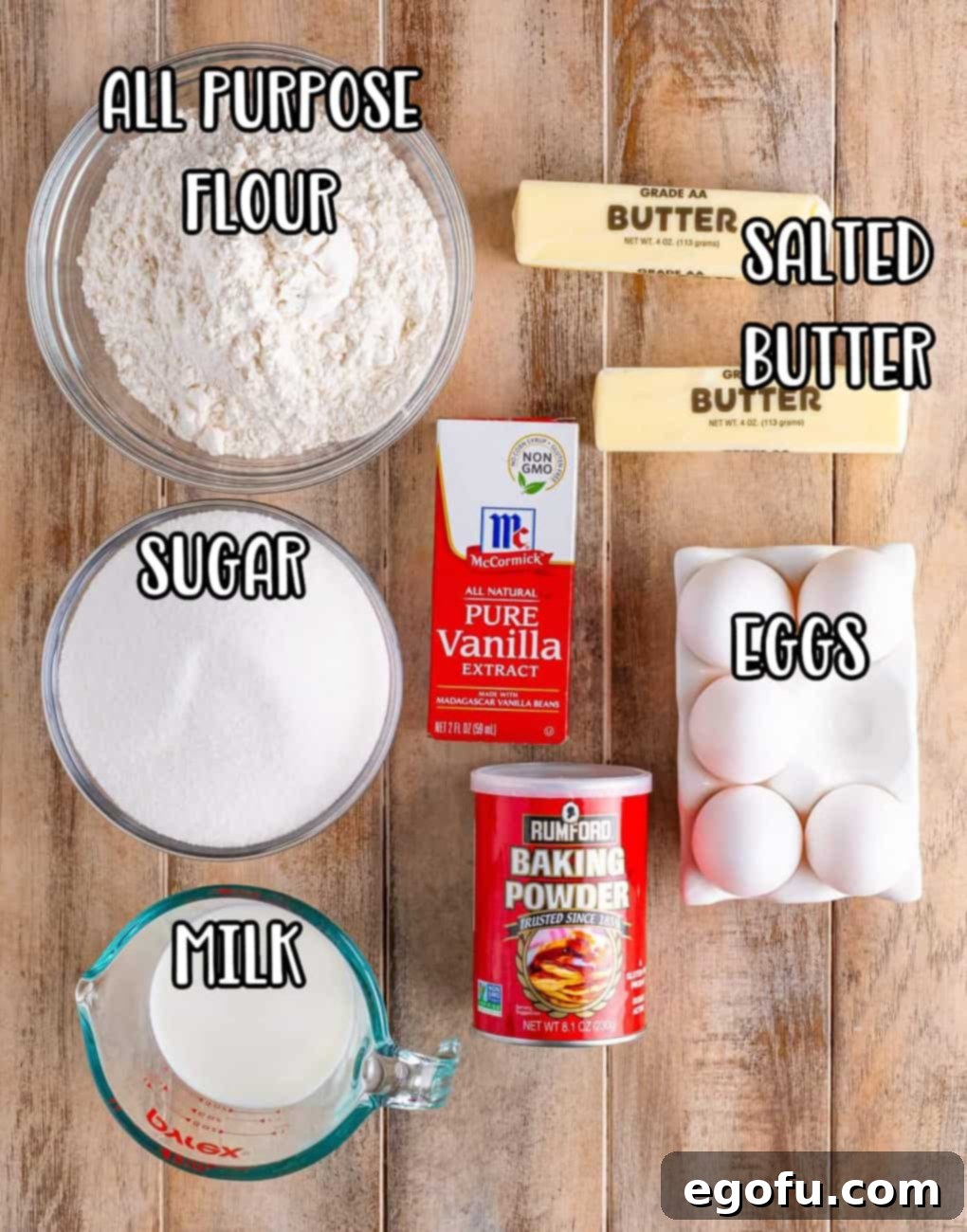
How to Bake Your Perfect Southern Pound Cake
Baking a Southern Pound Cake is a straightforward process, but paying attention to each step ensures a perfect, tender result every time.
- Prepare Your Pan and Oven: Begin by preheating your oven to 325°F (160°C). This lower temperature allows the cake to bake evenly without browning too quickly. Generously spray a 12-cup angel food cake pan (or a large Bundt pan) with baking spray, preferably one containing flour, to prevent sticking. Set the pan aside.
- Combine Dry Ingredients: In a medium bowl, whisk together the measured all-purpose flour and baking powder until well combined. This step ensures the leavening agent is evenly distributed throughout the dry mixture.
- Cream Butter and Sugar: In a large mixing bowl, using an electric hand mixer or a stand mixer fitted with the paddle attachment, cream together the softened salted butter and granulated sugar. Beat on medium-high speed until the mixture is light, fluffy, and pale in color, typically 3-5 minutes. This creaming process incorporates air, which is crucial for the pound cake’s texture.
- Incorporate Eggs and Vanilla: Add the large eggs, one at a time, beating well after each addition until fully incorporated before adding the next. This ensures a smooth, emulsified batter. Once all eggs are mixed in, stir in the vanilla extract until just combined.
- Alternate Dry and Wet Ingredients: With the mixer on low speed, gradually add half of the flour mixture to the wet ingredients, mixing until just combined. Be careful not to overmix. Scrape down the sides of the bowl as needed to ensure everything is incorporated.
- Add Milk and Remaining Ingredients: Pour in half of the whole milk and mix until just blended. Repeat with the remaining flour mixture and then the remaining milk, again mixing until just combined and scraping down the sides of the bowl as necessary. The final batter should be smooth and thick.
- Bake to Golden Perfection: Evenly spread the rich batter into your prepared angel food cake pan. Bake for 55-65 minutes, or until a wooden skewer or toothpick inserted into the center of the cake comes out clean. The top should be golden brown and spring back slightly when gently touched.
- Cool and Serve: Once baked, allow the cake to cool in the pan for 1 hour. This crucial cooling period helps the cake firm up and prevents it from breaking when you invert it. After an hour, carefully invert the cake onto your chosen serving dish or wire rack. Allow it to cool completely before slicing. If desired, dust with a delicate layer of powdered sugar just before serving for an elegant finish.
- Slice and Enjoy: With your perfectly baked Southern Pound Cake ready, it’s time to slice and savor every rich, buttery bite.
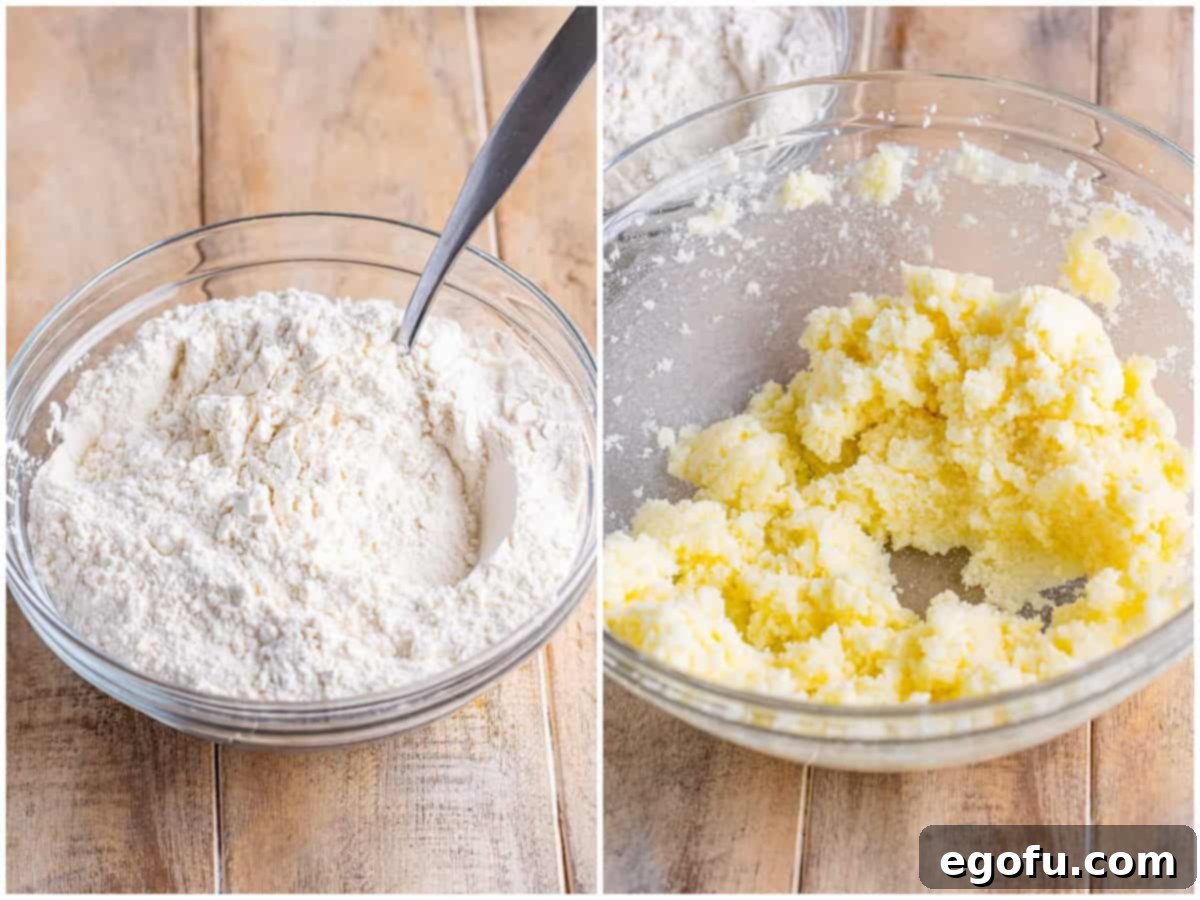

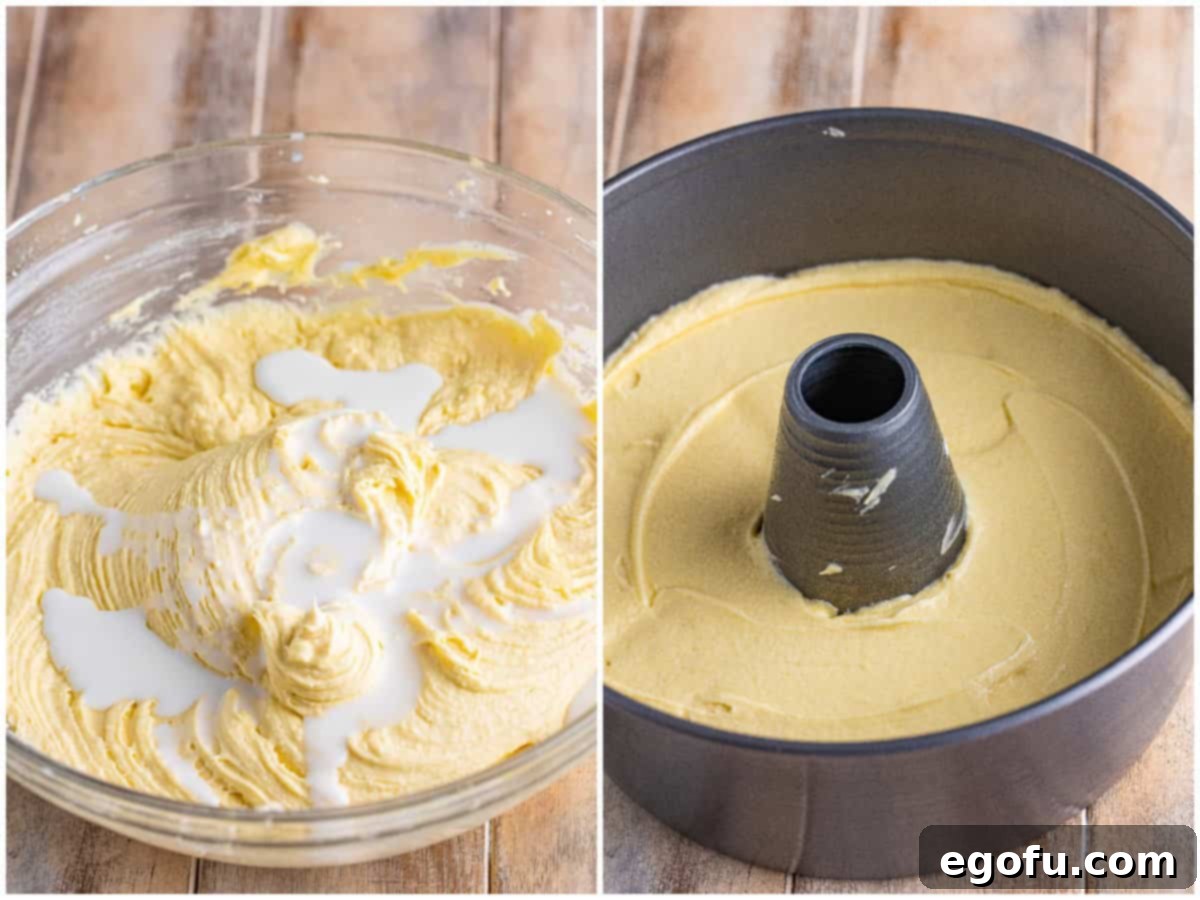
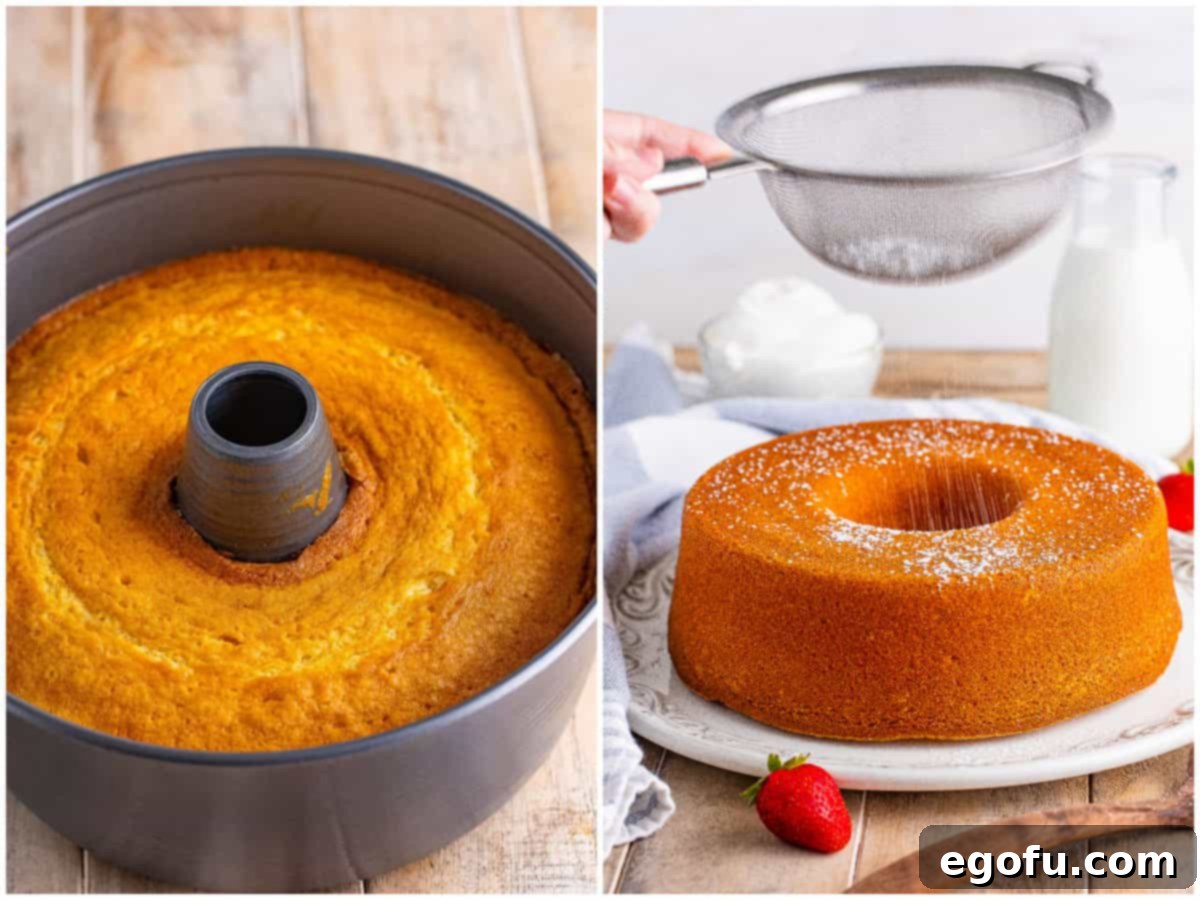
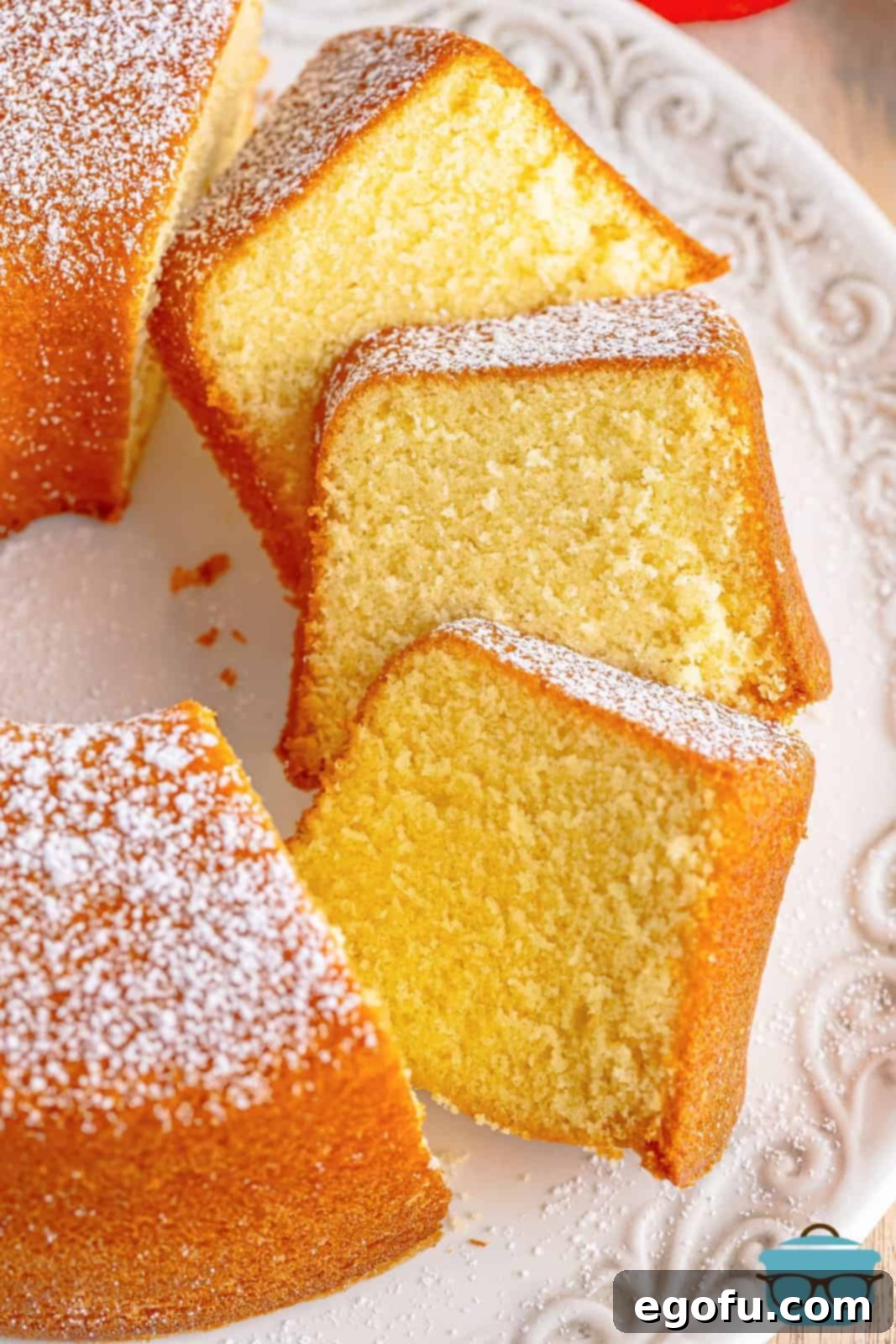
Craving More Classic Southern & Comforting Recipes?
- Southern Pecan Pound Cake
- Southern Caramel Cake
- Lemon Blueberry Pound Cake
- Sparkling Apple Cider Pound Cake
- Southern Hummingbird Cake
- Starbucks’ Lemon Loaf
- Cinnamon Roll Cake
- Italian Love Cake
- Italian Cream Cake
- Chocolate Sheet Cake
- White Texas Sheet Cake
- Homemade Yellow Cake Mix

Southern Pound Cake
Print
Pin
Ingredients
- 2 ¼ cups all-purpose flour
- 1 teaspoon baking powder
- 1 cup (2 sticks) salted butter, softened to room temperature
- 2 cups granulated sugar
- 5 large eggs, room temperature
- 1 Tablespoon vanilla extract
- ½ cup whole milk
- powdered sugar for dusting (optional)
Instructions
- Preheat the oven to 325°F. Spray a 12-cup angel food cake pan with baking spray (preferably with flour) and set aside.
- In a medium bowl, stir together the flour and baking powder.

- In a large bowl with an electric hand mixer or in the body of a stand mixer with the paddle attachment, cream the butter with the sugar until light and well blended.

- Add the eggs one at a time, making sure each one is fully mixed in before adding the next.

- Stir in the vanilla extract.

- Add half of the flour mixture, mix in well until just combined. Scrape the sides of the bowl as needed.

- Add half of the milk and mix in well. Repeat this process with the remaining flour and milk, mixing until just combined and scraping down the sides.

- Spread the batter evenly into the prepared pan. Bake for 55-65 minutes or until a toothpick inserted into the center comes out clean.

- Allow the cake to cool in the pan for 1 hour. Then, carefully invert the cake onto your serving dish or a wire rack. Let it cool completely until ready to serve. Dust with powdered sugar, if using, for a beautiful presentation.

- Slice into generous portions and enjoy the classic taste of Southern comfort!

Notes
- For more ingredient substitutions, troubleshooting tips, and answers to common questions, please refer to the comprehensive FAQ and ingredient list sections above.
- Bringing eggs to room temperature is key. This simple step helps them blend seamlessly into the batter, preventing curdling and contributing to a smoother batter and a finer, more consistent cake texture.
Nutrition
Carbohydrates: 52g |
Protein: 5g |
Fat: 18g |
Sodium: 153mg |
Fiber: 1g |
Sugar: 34g
Nutritional Disclaimer
“The Country Cook” is not a dietician or nutritionist, and any nutritional information shared is an estimate. If calorie count and other nutritional values are important to you, we recommend running the ingredients through whichever online nutritional calculator you prefer. Calories and other nutritional values can vary quite a bit depending on which brands were used.
